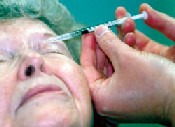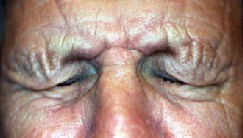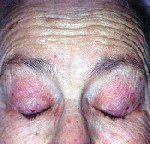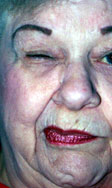We have yet to find all the potential medical uses of botulinum toxin. Researchers continue to develop new and unique medical applications for it. Ingested, botulinum toxin causes paralysis and even death (botulism). But when injected locally in small doses, the toxin serves to weaken or paralyze unwanted muscle function.
Botulinum toxin is perhaps best known to the public for its cosmetic use. But in this article Ill discuss how the toxin can help treat blepharospasm, strabismus and other ocular muscle disorders.
A Muscle Inhibitor

Figure 1: Subcutaneous injection into orbicularis oculi muscle for hemifacial spasm.
Botulinum toxin is the product of the bacteria Clostridium botulinum. Of all seven immunologically distinguishable exotoxins produced by the bacteria, three (A, B and E) cause paralysis in humans.1
Botulinum toxin inhibits the release of acetylcholine from the nerve terminal. Acetylcholine is a necessary ingredient in muscle contraction. Normally, once a nerve action potential reaches an axon terminal, the synaptic vesicles release acetylcholine molecules. These molecules then bind to and stimulate acetylcholine receptors, which ultimately trigger a muscle contraction.
Botulinum toxin shuts down this sequence of events by binding to the nerve terminal.2 Botulinum toxin enzymatically inactivates specific proteins that the acetylcholine-loaded vesicles need to dock and fuse into the neuromuscular junction.3 The toxin does not affect the synthesis or storage of acetylcholine or the conduction of electrical signals along the nerve terminal.4 But its action does result in a mild degree of demyelination, and the denervated muscle then atrophies.5
The effect takes approximately three to four days after injection to become clinically apparent.6 Effects are fully evident by two weeks after injection.7 The effect lasts approximately three to four months. This doesnt mean that the toxin must be present for this long at the nerve terminal. Rather, this duration reflects the length of time needed for a particular individuals nerves to regenerate and develop a functional connection at the myoneural junction.8 Denervation eventually reverses and complete recovery occurs as the affected docking proteins undergo intraneural turnover and as new axon terminals sprout with proliferating branches to form new synaptic contacts on the adjacent muscle fibers.9,10 Repeat injections do not appear to cause any long-term untoward effects.
Toxin Types
Two immunologically distinct neurotoxins are available for clinical use in the United States: Botox (botulinum toxin type A, Allergan) and Myobloc (botulinum toxin type B, Elan Pharmaceuticals).
Each vial of Botox contains 100 units of botulinum toxin in a powder form. The manufacturer recommends reconstitution with sterile, nonpreserved 0.9% sodium chloride solution, which must be used within four hours because it soon begins to deteriorate.11 (Preserved sodium chloride solution has also been used successfully to dilute the toxin, and it results in less patient discomfort on injection.12 This has been attributed to the presence of benzyl alcohol, which apparently has anesthetic properties, within the preserved saline.) Also, reconstituted Botox can be refrigerated, which retains potency for up to two weeks.13 (Neither refrigeration nor using preserved sodium chloride is recommended by the manufacturer at this time.)

Figure 2: Patient with BEB. Note the deep furrows indicating chronicity.
Botox may be reconstituted with 1ml to 8ml of saline to yield a variety of concentrations. The most commonly used dilution is 2.5 units per 0.1ml of volume at each injection site.11 To create a typical dosage, use 4ml of saline to reconstitute the botulinum powder, resulting in a concentration of 2.5 units/cc. Of that, 0.1cc or 0.2cc is typically administered at each site.
Myobloc comes premixed in a clear, colorless to light yellow sterile solution. It is available in three dosing volumes: 2,500 units/0.5ml, 5,000 units/1ml and 10,000 units/ 2ml. It can remain stable under refrigeration for up to 21 months.
Myobloc exists at a pH of 5.6 when in aqueous solution; this relatively acidic pH likely causes the increased discomfort patients complain about with its application.14 Myobloc has also been found to have less complete or shorter-duration muscle paralysis compared with Botox.15
Contraindications

Figure 3: Patient with ALO. Patient using forehead muscles to raise eyelids.
Botulinum toxin should not be used in patients who have neuromuscular disorders such as myasthenia gravis, Lambert-Eaton syndrome, or amyotrophic lateral sclerosis (ALS, or Lou Gehrigs disease). Certain antibiotics such as the aminoglycosides also preclude its use. These diseases and antibiotic agents can significantly potentiate the effects of the toxin since they affect acetylcholine-mediated neuromuscular transmission.16
This drug is also not recommended in pregnant women or nursing mothers, and should not be injected in areas where the overlying skin shows signs of infection or inflammation.
Finally, Botox and Myobloc both contain human albumin to stabilize the active ingredient. So, individuals with allergies to eggs should not receive botulinum toxin.6
Side Effects
When injected locally into the muscle, botulinum toxin binds to the tissues rapidly and firmly. There is little possibility of systemic effects caused by toxin passing into the circulatory system.5
Use of a larger dose than necessary, however, will result in more significant weakness or even complete paralysis of that muscle. This, in turn, can cause localized adverse events. For example, ptosis can occur if the levator palpebrae superioris muscle is injected incorrectly. Similarly, too large a dose in the orbicularis oculi muscle may result in decreased blinking and lagophthalmos with corneal compromise.6
Other, more generalized side effects include headache, respiratory infection, flu-like symptoms and nausea.17 Pain and bruising at the injection site are also common.
Blepharospasm Adding Botulinum Toxin to Your Practice
Botulinum toxin has been used extensively and successfully for various dystonias. Dystonia is a syndrome dominated by involuntary sustained (tonic) or spasmodic (rapid or clonic), patterned, repetitive muscle contractions, frequently causing twisting, flexing or extending and squeezing movements or abnormal postures.18
Benign essential blepharospasm (BEB) is the most common focal dystonia, occurring in an estimated 1 in 10,000 patients. BEB occurs bilaterally and involves the entire orbicularis oculi muscles, and the procerus and corrugator musculature (figure 2, page 54).19 It usually starts in people ages 50 to 70 (mean age 56), and women with BEB outnumber men by three to one.7,19,20
The onset of BEB begins as variable episodes of increased blinking that originally may be predominantly unilateral. BEB may progress to bilateral involuntary spasms of eyelid closure, and can result in functional blindness in up to 12% of patients.7,19 BEB may be precipitated or aggravated by stress, fatigue, reading, bright sunlight or driving (especially driving at night facing oncoming headlights).7,19 Certain activitiessuch as sleep, relaxation, walking, talking, or behavioral techniques or mannerisms (humming, singing, whistling, tapping the temple, solving puzzles or problems, etc.)can decrease the frequency and intensity of the spasms.19,21

Figure 4: Patient with hemifacial spasm.
When BEB is associated with intermittent lower facial movement, the disorder is known as Meige syndrome, or idiopathic orofacial dystonia. It frequently affects speech (causing dysarthria), and may cause involuntary chewing, trismus (lockjaw), and lip pursing. Blepharospasm is the central feature of Meige syndrome.22
Apraxia of lid opening (ALO) is a condition in which patients who have otherwise normal eyelids have difficulty opening their eyelids at will. The occurrence of ALO in BEB patients ranges from 7% to 19%.23 Patients with ALO raise their brows (forceful contraction of the frontalis muscle) in an effort to raise their eyelids (figure 3).21
Hemifacial spasm is characterized by unilateral, periodic, tonic contractions of the facial muscles of expression (figure 4). It usually begins in the orbicularis oculi muscle and spreads to involve the rest of the facial muscles.5 Hemifacial spasm is more common in middle-aged women and, unlike BEB, continues when the patient sleeps.19 Hemifacial spasm may be caused by a cerebellopontine tumor, or more commonly by microvascular compression or irritation of the facial nerve by an aberrant artery in the posterior fossa; all of these patients must undergo neuroimaging.5,9,19
Other Applications for Use
Botulinum toxin was first used to pharmacologically weaken extraocular muscles to correct nonaccommodative strabismus. It can also be used in acute third- and sixth-nerve palsies, strabismus smaller than 50.00 prism diopters, adults with recurrent childhood strabismus, post-operative residual strabismus two to eight weeks following surgery, strabismus following retinal detachment surgery, or when anesthesia or surgery is inappropriate, such as in active thyroid ophthalmopathy.5,20
Strabismus. The principle behind strabismus treatment is to cause temporary paresis in one of the extraocular muscles, resulting in a permanent change in the antagonist muscle after the paresis has worn off. Thus, in esotropia, when the medial rectus muscle is injected, its temporary weakening allows the antagonist lateral rectus muscle to shorten and tighten. When the medial rectus recovers, the increased stiffness of the lateral rectus realigns the eye in an improved or even straight position. With exotropia, injection of the lateral rectus allows the medial rectus to tighten.24 Results in horizontal strabismus are somewhat better than in vertical strabismus.20
The advantages of botulinum toxin injections in strabismus cases are its ease of administration, use of a topical anesthetic, little or no postinjection discomfort, and no postoperative recovery time since there is no surgical incision or residual scarring.5 The injection does need to be performed under electromyographic guidance with a Teflon-coated monopolar needle to ensure accurate placement in the extraocular muscle.9
Corneal compromise. If the patient needs corneal protection because of exposure problems (such as those seen with Bells palsy), injection into the levator superioris muscle can induce upper eyelid ptosis. Indolent ulcers can also heal faster after injection-induced ptosis.25
The public has many misconceptions about botulinum toxin, especially with all its exposure in the lay press and media. While botulinum toxin is the butt of jokes in comedy sitcoms and late-night talk shows, most patients do not truly understand what it does or what it cannot do.
So, the clinician must educate the patient about the fundamental aspects of this drug. Explain to the patient that botulinum toxin is a natural substance that, when used in the standard medical dosage, does not cause botulism or poisoning.
Let the patient know that it is administered via a few tiny injections and that treatment is simple, quick and minimally invasive. There is no downtime for the patient and, although the effect is not permanent, any overtreatment wears off and future injections can be adjusted to obtain a more desirable clinical result.
Do not use terms such as fixed, frozen, paralyzed, deaden or needles.
In your chart, document the ICD9-CM code that supports medical necessity (333.81blepharospasm; 351.8hemifacial spasm/other facial nerve disorders) and make a notation that the patient has been unresponsive to conventional methods of controlling or treating his or her condition.
The procedure note should include the dilution used per unit, number of injections, injection sites (a diagram is very helpful for future injections), units injected at each site, amount of medication wasted, and the results and response to the injections. Hemifacial spasm treatment is considered a unilateral procedure while blepharospasm treatment is bilateral. It is usually not considered medically necessary to give botulinum toxin injection for blepharospasm or hemifacial spasm more frequently than every 90 days.
The CPT code to use for this application is 64612chemodenervation of muscle(s); muscles innervated by facial nerve.
To get reimbursed for the medication used and wasted (if any), HCPCS code J0585 should also be appended. For example, if only 45 units of Botox (100 units in one vial) are used in a blepharospasm patient, then 55 units would be wasted. Medicare and most other private insurance companies allow the doctor to bill the patient for both. It is more economical to the patient if more than one patient is scheduled and the vial is split between two patients. Each patient is then billed for the exact amount used on each individual. One can split the expense of the wastage among the patients.L.S.
Nystagmus. Patients with acquired nystagmus that produces oscillopsia and decreased visual acuity can be helped if the toxin is injected into the retrobulbar space of all the extraocular muscles.26
Eyelid retraction. Upper eyelid retraction, as in thyroid eye disease, can be successfully treated by transcutaneous injection of botulinum toxin between the orbital roof and the levator palpebrae superioris muscle, or via the transconjunctival route if both the levator and Mellers muscles are injected.27,28
Bells palsy. Patients who do not recover completely from Bells palsy can develop various stigmata of axonal degeneration. Facial nerve misdirection from aberrant regeneration may lead to a jaw-wink presentation (eye blink with jaw movement) or excessive lacrimation with chewing, also known as crocodile tears.29 Other stigmata include involuntary eyelid muscle spasms or contractures and facial myokymia (involuntary facial muscle twitching).
These aberrant movements can be treated with botulinum toxin by injecting the offending muscles directly.5 A transconjunctival injection of botulinum toxin directly into the lacrimal gland has been shown to temporarily eliminate crocodile tearing.30
Other unique ocular uses. Injecting the toxin into the medial lower lid causes medial ectropion in patients with dry eye. This causes the puncta to turn out, which helps retain the tears longer in the patients eye.31
Another use: Injecting the toxin into the medial rectus muscles helps patients with chronic spasm of near reflex.32
Headache. The latest medical application of botulinum toxin is in the field of headache therapy, and has been found to be efficacious in migraine, tension-type, cervicogenic and chronic daily headache.
Botulinum toxin has been also used successfully in other areas of medicine. These include: cervical dystonia (spasmodic torticollis); spasmodic dysphonia (spastic vocal chord closure); axillary and palmar hyperhidrosis (excessive sweating of underarms and palms); adjunct to facial wound healing (relaxes tension on wounds); writers and musicians cramp (repetitive motion spasms); spasticity of multiple sclerosis, cerebral palsy and stroke; spasms of the rectal sphincter; anal fissure and hyperreflexic bladder.
Botulinum toxin appears to have myriad uses. This is due to the toxins very basic mechanism of actionpreventing a nerve from communicating with a muscle. This is a rudimentary interaction that occurs in many illnesses. So, the possible uses for botulinum toxin most likely will continue to grow in the future.
Dr. Skorin is the staff ophthalmologist at Albert Lea Eye Clinic-Mayo Health System, Albert Lea, Minn. He lectures and does workshops on botulinum toxin, and has used it in his practice for almost 14 years.
1. McCann JD, Saulny S, Goldberg RA, Anderson RL. Essential blepharospasm. In: Chen WP, ed. Oculoplastic Surgery: The Essentials. New York: Thieme, 2001:113-24.
2. Lebeda FJ, Hack DC, Bentry MK. Theoretical analyses of the functional regions of the heavy chain of botulinum neurotoxin. In: Jankovic J, Hallet M, eds. Therapy with Botulinum Toxin. New York: Marcel Dekker Inc., 1994:51-61.
3. Popoff MR, Marvaud JC, Raffestin S. [Mechanism of action and therapeutic uses of botulinum and tetanus neurotoxins] Ann Pharm Fr 2001 May;59(3):176-90.
4. Harvey AL. Presynaptic toxins. In: Smythies JR, Bradley RJ, eds. Intervention Review of Neurobiology. San Diego: Academic Press, 1990;32:201-39.
5. Osako M, Keltner JL. Botulinum A toxin (Oculinum) in ophthalmology. Surv Ophthalmol 1991 Jul-Aug;36(1):28-46.
6. Lipham WJ. What is botulinum toxin and how does it work? In: Lipman WJ, ed. Cosmetic and Clinical Applications of Botulinum Toxin. Thorofare, N.J.: Slack Inc., 2004:5-9.
7. Skorin L. Spasms, twitches and other eyelid glitches. Pract Optom 2001;12:194-202.
8. Edelstein C, Shorr N, Jacobs J, et al. Oculoplastic experience with the cosmetic use of botulinum A exotoxin. Dermatol Surg 1998 Nov;24(11):1208-12.
9. Jankovic J, Brin MF. Therapeutic uses of botulinum toxin. N Eng J Med 1991 Apr 25;324(17):1186-94.
10. Keller JE, Neale EA, Oyler G, Adler M. Persistence of botulinum neurotoxin action in cultured spinal cord cells. FEBS Lett 1999 Jul 30;456(1):137-42.
11. Skorin L, Muchnick BG. Neuro-ophthalmic disorders. In: Bartlett JD, Jaanus SD, eds. Clinical Ocular Pharmacology. 4th ed. Boston: Butterworth Heinemann, 2001:433-84.
12. Alam M, Dover JS, Arndt KA. Pain associated with injection of botulinum A exotoxin reconstituted using isotonic sodium chloride with and without preservative: a double-blind, randomized controlled trial. Arch Dermatol 2002 Apr;138(4):510-4.
13. Sloop RR, Cole BA, Escutin RO. Reconstituted botulinum toxin type A does not lose potency in humans if it is refrozen or refrigerated for 2 weeks before use. Neurology 1997 Jan;48(1):249-53.
14. Ramirez AL, Reeck J, Maas CS. Botulinum toxin type B (Myobloc) in the management of hyperkinetic facial lines. Otolaryngol Head Neck Surg 2002 May;126(5):459-67.
15. Sloop RR, Cole BA, Escutin RO. Human response to botulinum toxin injection: type B compared with type A. Neurology 1997 Jul;49(1):189-94.
16. Matarasso SL. Complications of botulinum A exotoxin for hyperfunctional lines. Dermatol Surg 1998 Nov;24(11):1249-54.
17. Carruthers JA, Lowe NJ, Menter AA, et al. A multicenter, double-blind, randomized, placebo-controlled study of the efficacy and safety of botulinum toxin type A in the treatment of glabellar lines. J Am Acad Dermatol 2002 Jun;46(6):840-9.
18. Jankovic J, Fahn S. Dystonic syndromes. In: Jankovic J, Tolosa E, eds. Parkinsons disease and movement disorders. Baltimore: Urban & Schwarzenberg, 1988:283-314.
19. Patel BCK, Anderson RL. Essential blepharospasm and related diseases. Focal Points Clinical Modules for Ophthalmologists. San Francisco: The American Academy of Ophthalmology, 2000;18:1-13.
20. Skorin L. Botulinum toxin and its uses. In: Onofrey BE, ed. Clinical Optometric Pharmacology and Therapeutics. Philadelphia: Lippincott-Raven, 1993:1-6.
21. Patel BCK, Anderson RL. Surgical management of essential blepharospasm. In: Mauriello JA, ed. Unfavorable Results of Eyelid and Lacrimal Surgery: Prevention and Management. Boston: Butterworth Heinemann, 2000:181-204.
22. Tolosa E, Kulisevsky J, Fahn S. Meige syndrome: primary and secondary forms. Adv Neurol 1988;50:509-15.
23. Boghen D. Apraxia of lid opening: A review. Neurology 1997 Jun;48(6):1491-4.
24. Windt JH. Botulinum toxin injections: A useful treatment adjunct for blepharospasm and strabismus. Ophthalmol World News 1995;1:39.
25. Kirkness CM, Adams GG, Dilly PN, Lee JP. Botulinum toxin A-induced protective ptosis in corneal disease. Ophthalmology 1988 Apr;95(4):473-80.
26. Helveston EM, Pogrebniak AE. Treatment of acquired nystagmus with botulinum A toxin. Am J Ophthalmol 1988 Nov 15;106(5):584-6.
27. Biglan AW. Control of eyelid retraction associated with Graves disease with botulinum A toxin Ophthalmic Surg 1994 Mar;25(3):186-8.
28. Uddin JM, Davies PD. Treatment of upper eyelid retraction associated with thyroid eye disease with subconjunctival botulinum toxin injection. Ophthalmology 2002 Jun;109(6):1183-7.
29. Gates GA. Facial palsy. In: Samuels MA, Feske S, eds. Office Practice of Neurology. New York: Churchill Livingstone 1996:74-83.
30. Montoya FJ, Riddell CE, Caesar R, Hague S. Treatment of gustatory hyperlacrimation (crocodile tears) with injection of botulinum toxin into the lacrimal gland. Eye 2002 Nov;16(6):705-9.
31. Sahlin S, Chen E, Kaugesaar T, et al. Effect of eyelid botulinum toxin injection on lacrimal drainage. Am J Ophthalmol 2000 Apr;129(4):481-6.
32. Rutstein R, Than T, Cogen M. Botulinum toxin injection for a patient with chronic spasm of the near reflex. J Am Acad Optom Suppl 2002;79:218.

